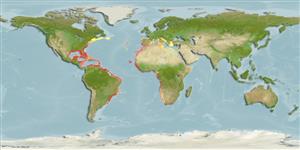Classificação / Names
Common names from other countries
Referência principal
Tamanho / Peso / Idade
Max length : 124 cm TL macho/indeterminado; (Ref. 5217); common length : 75.0 cm TL macho/indeterminado; (Ref. 2683); Peso máx. publicado: 32.0 kg (Ref. 27584)
Length at first maturity
Lm 66.0 range ? - ? cm
Ambiente
; marinhas; estuarina associadas(os) a recifes; oceanódromo (Ref. 51243); intervalo de profundidade 1 - 350 m (Ref. 7097), usually 1 - 200 m (Ref. 55173)
Clima / Intervalo
Subtropical, preferred 27°C (Ref. 107945); 45°N - 33°S, 98°W - 14°E
Distribuição
Eastern Atlantic: Portugal to Angola, including the western Mediterranean. Western Atlantic: Nova Scotia, Canada and northern Gulf of Mexico to Uruguay (Ref. 7251), including the Greater Antilles (Ref. 9626). Absent from eastern Lesser Antilles (Ref. 26938). Indian Ocean records are probably misidentifications of Caranx ignobilis. Reports from Pacific refer to Caranx caninus, which may be conspecific.
Países | Áreas FAO | Ecossistemas | Ocorrências | Introduções
Descrição breve
Espinhos dorsais (total): 9; Raios dorsais moles (total): 19-22; Espinhos anais 3; Raios anais moles: 15 - 18. Diagnosis: Scutes on lateral line 23 (Ref. 57392) to 42 (Ref. 13442). No scales on chest (Ref. 13442), except a small mid-ventral patch in front of pelvic fins (Ref. 13442, 57392). Upper profile of head steep (Ref. 13442). Maxilla ending approximately below (Ref. 13442, 57392) or beyond (Ref. 57392) posterior edge of eye (in adult). Front of soft dorsal and anal fins elevated; olivaceous to bluish green dorsally, silvery to brassy on the sides; prominent black spot posteriorly on gill cover at level of eye, another at upper axil of pectoral fins, and often a third on lower pectoral rays; caudal yellowish (Ref. 13442).
Categoria na Lista Vermelha da IUCN (Ref. 115185)
Ameaça para o homem
Reports of ciguatera poisoning (Ref. 4690)
Utilização humana
Pescarias: espécies comerciais; peixe desportivo: sim
Ferramentas
Relatórios especiais
Descarregue XML
Fontes da internet
Estimates of some properties based on models
Phylogenetic diversity index
PD50 = 0.5000 many relatives (e.g. carps) 0.5 - 2.0 few relatives (e.g. lungfishes)
Nível Trófico
3.6 ±0.4 se; Based on diet studies.
Resiliência
Médio, tempo mínimo de duplicação da população 1,4 - 4,4 anos (Assuming tm 3-4)
Vulnerabilidade
Moderate vulnerability (41 of 100)
Categoria de preço
